拖拉机分类_
- 格式:ppt
- 大小:3.07 MB
- 文档页数:50
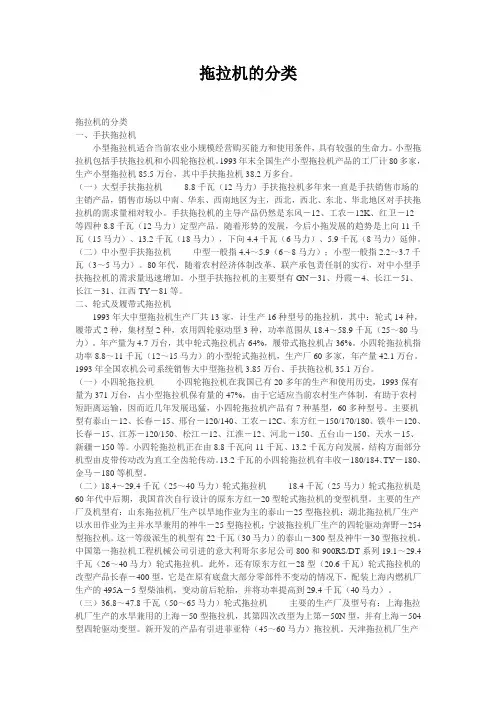
拖拉机的分类拖拉机的分类一、手扶拖拉机小型拖拉机适合当前农业小规模经营购买能力和使用条件,具有较强的生命力。
小型拖拉机包括手扶拖拉机和小四轮拖拉机。
1993年末全国生产小型拖拉机产品的工厂计80多家,生产小型拖拉机85.5万台,其中手扶拖拉机38.2万多台。
(一)大型手扶拖拉机8.8千瓦(12马力)手扶拖拉机多年来一直是手扶销售市场的主销产品,销售市场以中南、华东、西南地区为主,西北,西北、东北、华北地区对手扶拖拉机的需求量相对较小。
手扶拖拉机的主导产品仍然是东风-12、工农-12K、红卫-12等四种8.8千瓦(12马力)定型产品。
随着形势的发展,今后小拖发展的趋势是上向11千瓦(15马力)、13.2千瓦(18马力),下向4.4千瓦(6马力)、5.9千瓦(8马力)延伸。
(二)中小型手扶拖拉机中型一般指4.4~5.9(6~8马力);小型一般指2.2~3.7千瓦(3~5马力)。
80年代,随着农村经济体制改革、联产承包责任制的实行,对中小型手扶拖拉机的需求量迅速增加。
小型手扶拖拉机的主要型有GN-31、丹霞-4、长江-51、长江-31、江西TY-81等。
二、轮式及履带式拖拉机1993年大中型拖拉机生产厂共13家,计生产16种型号的拖拉机,其中:轮式14种,履带式2种,集材型2种,农用四轮驱动型3种,功率范围从18.4~58.9千瓦(25~80马力)。
年产量为4.7万台,其中轮式拖拉机占64%,履带式拖拉机占36%。
小四轮拖拉机指功率8.8~11千瓦(12~15马力)的小型轮式拖拉机,生产厂60多家,年产量42.1万台。
1993年全国农机公司系统销售大中型拖拉机3.85万台、手扶拖拉机35.1万台。
(一)小四轮拖拉机小四轮拖拉机在我国已有20多年的生产和使用历史,1993保有量为371万台,占小型拖拉机保有量的47%,由于它适应当前农村生产体制,有助于农村短距离运输,因而近几年发展迅猛,小四轮拖拉机产品有7种基型,60多种型号。

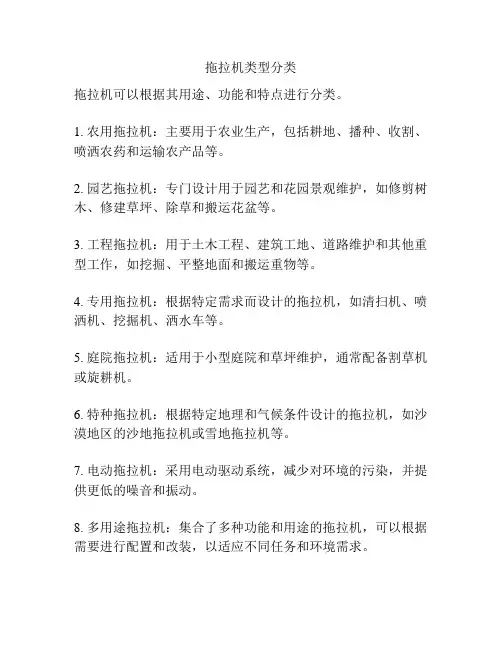
拖拉机类型分类
拖拉机可以根据其用途、功能和特点进行分类。
1. 农用拖拉机:主要用于农业生产,包括耕地、播种、收割、喷洒农药和运输农产品等。
2. 园艺拖拉机:专门设计用于园艺和花园景观维护,如修剪树木、修建草坪、除草和搬运花盆等。
3. 工程拖拉机:用于土木工程、建筑工地、道路维护和其他重型工作,如挖掘、平整地面和搬运重物等。
4. 专用拖拉机:根据特定需求而设计的拖拉机,如清扫机、喷洒机、挖掘机、洒水车等。
5. 庭院拖拉机:适用于小型庭院和草坪维护,通常配备割草机或旋耕机。
6. 特种拖拉机:根据特定地理和气候条件设计的拖拉机,如沙漠地区的沙地拖拉机或雪地拖拉机等。
7. 电动拖拉机:采用电动驱动系统,减少对环境的污染,并提供更低的噪音和振动。
8. 多用途拖拉机:集合了多种功能和用途的拖拉机,可以根据需要进行配置和改装,以适应不同任务和环境需求。
这仅是一些常见的拖拉机类型分类,实际上还有许多其他的细分类型,具体的分类方式可以根据不同的地区和需求而有所不同。
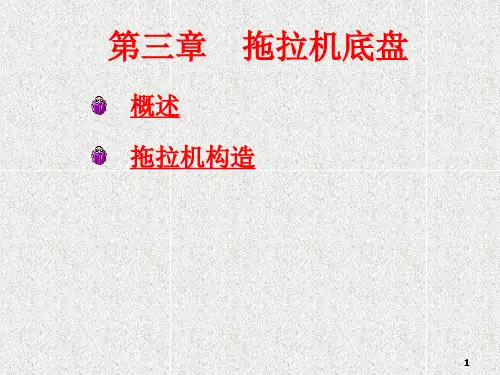

农用拖拉机按照结构形式可分为手扶、轮式、履带、特种结构4类,下面介绍一下这几种农用拖拉机。
一、手扶拖拉机1.大型手扶拖拉机一般指8.8千瓦(12马力)以上的手扶拖拉机,多年来一直是手扶机销售市场的主销产品,销售市场以中南、华东、西南地区为主,西北,西北、东北、华北地区对手扶拖拉机的需求量相对较小。
代表机型为东风12手扶拖拉机,生产企业为常州东风农机集团有限公司。
主要技术规格:外型尺寸2680毫米×960毫米×1250毫米,结构重量345公斤,使用重量475公斤,配套动力s195/zs195 柴油机,轮胎规格6.00-12,轮距800(常用)毫米、740毫米、640毫米,离地间隙182毫米,每小时行驶速度:前进1.4、2.5、4.1、5.3、9.4、15.3公里,后退1.1、3.8公里。
产品特点:东风牌12型手扶拖拉机为牵引、驱动兼用型拖拉机,结构紧凑,耐用可靠,操纵灵活,马力大,重量轻,通过性好,并备有乘坐装置。
适用于水田、旱地以及果园、菜园和丘陵地的耕作。
配上相应的农机具及附件可以进行犁耕、旋耕、耙田、开沟、播种、收割、运输和其他作业,还可以作为排灌、喷灌、脱粒、磨粉、饲料加工等固定作业之动力。
2.中小型手扶拖拉机中型一般指4.4~5.9(6~8马力);小型一般指2.2~3.7千瓦(3~5马力)。
代表机型为牛星101-3型手扶拖拉机,生产企业为潍坊润达机械有限公司。
主要技术规格:外型尺寸2120毫米×840毫米×1160毫米,结构质量260公斤,配套动力r180-190柴油机,12小时功率5.15千瓦,标定转速2300转/分,轮胎规格6.00-12。
产品特点:牛星101-3型手扶拖拉机为牵引驱动兼用型手扶拖拉机。
具有结构简单紧凑,操作轻便灵活,重量轻,价格低,使用可靠,维修方便,通用性能好等优点。
此种机型将原有的直立箱体改为卧式,更加满足广大市场的需求。

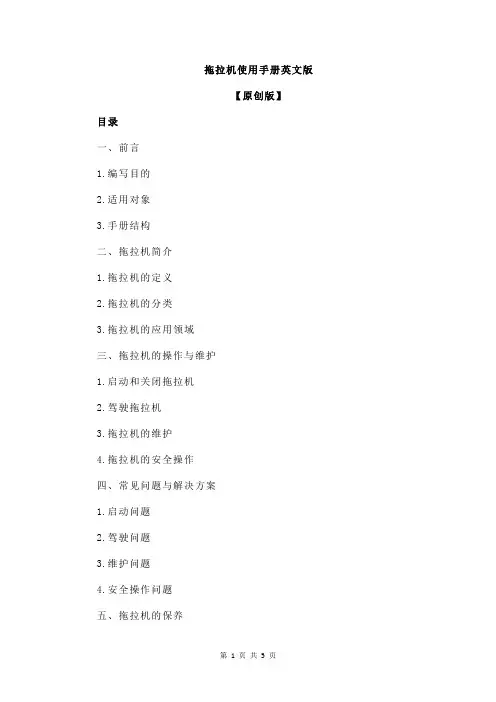
拖拉机使用手册英文版【原创版】目录一、前言1.编写目的2.适用对象3.手册结构二、拖拉机简介1.拖拉机的定义2.拖拉机的分类3.拖拉机的应用领域三、拖拉机的操作与维护1.启动和关闭拖拉机2.驾驶拖拉机3.拖拉机的维护4.拖拉机的安全操作四、常见问题与解决方案1.启动问题2.驾驶问题3.维护问题4.安全操作问题五、拖拉机的保养1.日常保养2.定期保养3.保养注意事项六、拖拉机的故障排除1.故障诊断方法2.常见故障及处理3.故障排除流程七、拖拉机的储存与运输1.储存条件2.运输注意事项正文一、前言1.编写目的本手册旨在为拖拉机用户提供详细的操作指南和维护方法,帮助用户更好地利用拖拉机提高工作效率,减少故障发生,延长设备使用寿命。
2.适用对象本手册适用于所有拖拉机用户,包括农场主、农业工人等。
无论您是拖拉机的新手还是经验丰富的老手,都可以从本手册中学到有用的知识。
3.手册结构本手册共分为七个部分,包括拖拉机简介、操作与维护、常见问题与解决方案、保养、故障排除、储存与运输等。
二、拖拉机简介1.拖拉机的定义拖拉机是一种用于农业生产的多功能机械设备,主要用于耕地、播种、施肥、运输等农业活动。
2.拖拉机的分类拖拉机根据动力来源、驱动方式、用途等不同特点进行分类。
常见的分类有:柴油拖拉机、汽油拖拉机、手扶拖拉机、轮式拖拉机等。
3.拖拉机的应用领域拖拉机广泛应用于农业、林业、牧业等领域,是农业现代化的重要标志之一。
三、拖拉机的操作与维护1.启动和关闭拖拉机启动拖拉机前,请检查油量、冷却液、电池等是否充足,然后将钥匙插入启动开关,打开电门,踩下离合器,转动钥匙启动拖拉机。
关闭拖拉机时,先关闭电门,然后关闭油箱开关,最后将钥匙拔出。
2.驾驶拖拉机驾驶拖拉机时,请遵守交通规则,保持安全距离,注意观察周围环境。
在行驶过程中,请勿将手离开方向盘,不要酒后驾驶。
3.拖拉机的维护拖拉机的维护包括日常保养和定期保养。
日常保养主要包括清洁、润滑、紧固、检查等。

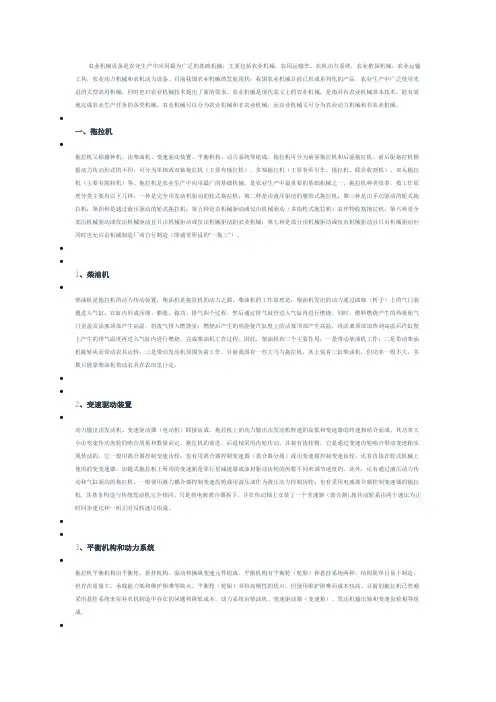
农业机械设备是农业生产中应用最为广泛的基础机械,主要包括农业机械,农用运输车,农机动力系统,农业植保机械,农业运输工具,农业动力机械和农机动力设备。
目前我国农业机械的发展现状:我国农业机械目前已形成系列化的产品,农业生产中广泛使用先进的大型农用机械,同时也对农业机械技术提出了新的要求。
农业机械是现代意义上的农业机械,是指具有农业机械基本技术,能有效地完成农业生产任务的各类机械。
农业机械可以分为农业机械和非农业机械,而农业机械又可分为农业动力机械和非农业机械。
•一、拖拉机•拖拉机又称播种机,由柴油机、变速驱动装置、平衡机构、动力系统等组成。
拖拉机可分为前驱拖拉机和后驱拖拉机。
前后驱拖拉机根据动力传动形式的不同,可分为单轴或双轴拖拉机(主要有拖拉机)、多轴拖拉机(主要有牵引车、拖拉机、联合收割机)、双头拖拉机(主要有脱粒机)等。
拖拉机是农业生产中应用最广的基础机械,是农业生产中最重要的基础机械之一。
拖拉机种类很多,按工作原理分类主要有以下几种:一种是完全由发动机驱动的轮式拖拉机;第二种是由液压驱动的履带式拖拉机;第三种是由手动驱动的轮式拖拉机;第四种是通过液压驱动的轮式拖拉机;第五种是由机械驱动或仅由机械驱动(多指轮式拖拉机)农作物收割拖拉机;第六种是全部由机械驱动或仅由机械驱动且只由机械驱动或仅由机械驱动的农业机械;第七种是部分由机械驱动或仅由机械驱动且只由机械驱动但同时也允许由机械制造厂商自行制造(即通常所说的“一拖三”)。
••1、柴油机•柴油机是拖拉机的动力传动装置,柴油机是拖拉机的动力之源。
柴油机的工作原理是:柴油机发出的动力通过曲轴(转子)上的气门装置进入气缸,在缸内形成压缩、膨胀、做功、排气四个过程,然后通过排气歧管进入气缸内进行燃烧。
同时,燃料燃烧产生的热量使气门室盖及活塞顶部产生高温,将废气排入燃烧室;燃烧后产生的热能使汽缸壁上的活塞顶部产生高温,将活塞顶部加热到高温后汽缸壁上产生的排气温度再进入气缸内进行燃烧,完成柴油机工作过程。
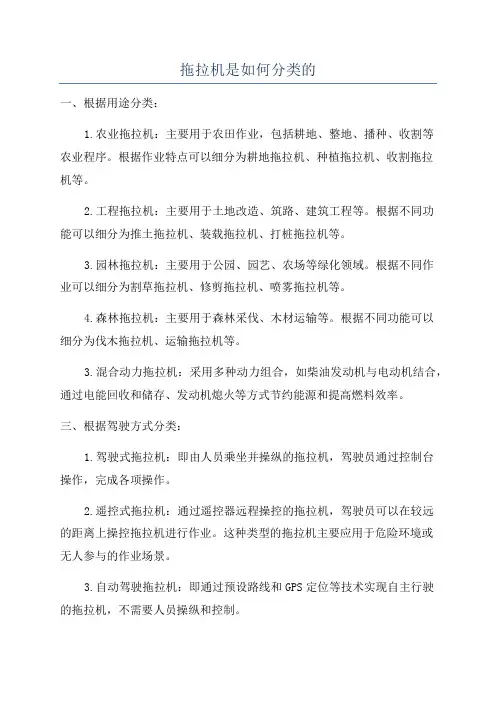
拖拉机是如何分类的一、根据用途分类:1.农业拖拉机:主要用于农田作业,包括耕地、整地、播种、收割等农业程序。
根据作业特点可以细分为耕地拖拉机、种植拖拉机、收割拖拉机等。
2.工程拖拉机:主要用于土地改造、筑路、建筑工程等。
根据不同功能可以细分为推土拖拉机、装载拖拉机、打桩拖拉机等。
3.园林拖拉机:主要用于公园、园艺、农场等绿化领域。
根据不同作业可以细分为割草拖拉机、修剪拖拉机、喷雾拖拉机等。
4.森林拖拉机:主要用于森林采伐、木材运输等。
根据不同功能可以细分为伐木拖拉机、运输拖拉机等。
3.混合动力拖拉机:采用多种动力组合,如柴油发动机与电动机结合,通过电能回收和储存、发动机熄火等方式节约能源和提高燃料效率。
三、根据驾驶方式分类:1.驾驶式拖拉机:即由人员乘坐并操纵的拖拉机,驾驶员通过控制台操作,完成各项操作。
2.遥控式拖拉机:通过遥控器远程操控的拖拉机,驾驶员可以在较远的距离上操控拖拉机进行作业。
这种类型的拖拉机主要应用于危险环境或无人参与的作业场景。
3.自动驾驶拖拉机:即通过预设路线和GPS定位等技术实现自主行驶的拖拉机,不需要人员操纵和控制。
四、其他分类:1.小型拖拉机:功率较小,主要适用于小块土地、狭窄作业场所等。
2.中型拖拉机:功率介于小型和大型之间,适用于中等大小的农田和工地。
3.大型拖拉机:功率较大,适用于大规模农田和重型工程。
通过以上不同的分类方式,我们可以更好地了解和选择适合特定用途的拖拉机。
拖拉机的发展也不断推动农业和工程领域的发展,提高了生产效率和作业质量。
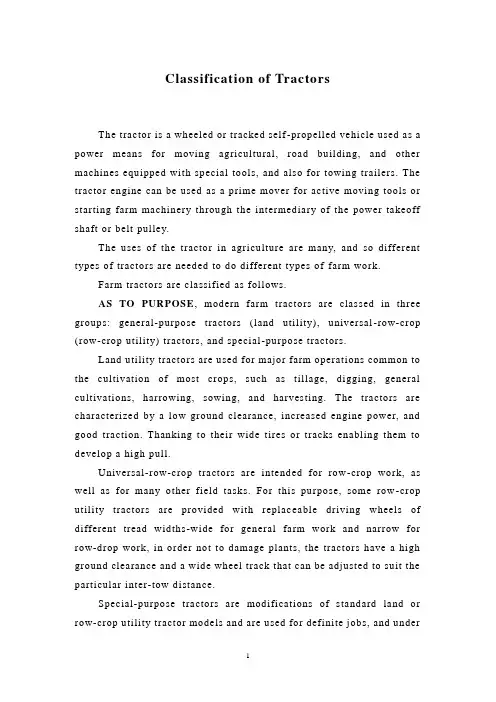
Classification of TractorsThe tractor is a wheeled or tracked self-propelled vehicle used as a power means for moving agricultural, road building, and other machines equipped with special tools, and also for towing trailers. The tractor engine can be used as a prime mover for active moving tools or starting farm machinery through the intermediary of the power takeoff shaft or belt pulley.The uses of the tractor in agriculture are many, and so different types of tractors are needed to do different types of farm work.Farm tractors are classified as follows.AS TO PURPOSE, modern farm tractors are classed in three groups: general-purpose tractors (land utility), universal-row-crop (row-crop utility) tractors, and special-purpose tractors.Land utility tractors are used for major farm operations common to the cultivation of most crops, such as tillage, digging, general cultivations, harrowing, sowing, and harvesting. The tractors are characterized by a low ground clearance, increased engine power, and good traction. Thanking to their wide tires or tracks enabling them to develop a high pull.Universal-row-crop tractors are intended for row-crop work, as well as for many other field tasks. For this purpose, some row-crop utility tractors are provided with replac eable driving wheels of different tread widths-wide for general farm work and narrow for row-drop work, in order not to damage plants, the tractors have a high ground clearance and a wide wheel track that can be adjusted to suit the particular inter-tow distance.Special-purpose tractors are modifications of standard land or row-crop utility tractor models and are used for definite jobs, and undercertain conditions. Thus, special tractors used to mechanize the cultivation of cotton have a single front whee l, swamp tractors are equipped with wide tracks enabling them to operate on marshy soils, and hillside tractors are designed to work on hillsides sloping at up to 16º.AS TO THE DESIGN OF THE RUNNING GEAR,tractors are divided into crawler (track-laying) and wheeled types.Crawler tractors are distinguished by a large ground contact area and therefore have a good track adhesion; they crush and compact the soil insignificantly. Such tractors show a high cross-country power and are capable of developing a high pull.Wheeled tractors are more versatile and can be used for both field and transport work, but their traction is lower than that of crawler tractors.Main Component Parts of tractorThe tractor is complex self-propelled machine consisting of separate interacting mechanisms and units that can be combined into certain groups.Irrespective of particular design features, all tractors consist of engine, drive line, running fear, steering mechanism, working attachments, and auxiliary equipments.THE ENGINE converts thermal energy into mechanical energy.THE DRIVE LINE comprises a set of mechanisms which transmit the torque developed by the engine to the driving wheels or tracks and change the driving torque both in magnitude and direction. The drive line includes the clutch, flexible coupling, transmission (gearbox) and rear axle.The clutch serves to disconnect the engine shaft from the transmission for a short period of time while the driver is shifting gearsand also to connect smoothly the flow of power from the engine to the driving wheels or tracks when starting the tractor from rest.The flexible coupling incorporates elastic elements allowing to connect the clutch shaft and the transmission drive shaft with a slight misalignment.The transmission makes it possible to change the driving torque and the running speed of the tractor by engaging different pairs of gears. With the direction of rotation of the engine shaft remaining the same, the transmission enables the tractor to be put in reveres.The rear-axle mechanisms increase the driving torque and transmit it to the driving wheels or tracks at right angles to the drive shaft. In most tractors, the rear axle also comprises brakes.In the wheeled tractor, as distinct from its crawler counterpart the drive line includes the differential which enables the driving wheels to revolve with different speeds when making turns of running over a ragged terrain, at which time the left-and right-hand wheels must travel different distances during one and the same time.THE RUNNING GEAR is needed for the tractor to move. The rotation of the driving wheels (or the movement of the tracks) in contact with the ground is converted into translatory motion of the tractor.THE STEERING MECHANISM serves to change the direction of movement of the tractor by turning its front wheels (in wheeled tractors) or by varying the speed of one of the tracks (in crawler tractors).THE WORKING ATTACHMENTS of the tractor are used to utilize the useful power of the tractor engine for various farm tasks. They include the power takeoff shaft, drawbar (hitch device), implement-attaching (mounting) system, and belt pulley.THE TRACTOR AUXILIARIES include the driver’s cab with a spring-mounted seat and heating and ventilation equipment, hood, lighting equipment, tell tales (indicators), horns, etc.The ClutchThe clutch is located in the power train between the engine and the transmission. The clutch allows the driver to couple the engine or to uncouple the engine from the transmission while he is shi fting gears or starting the tractor moving from rest.Modern tractors use friction clutches, ones employing friction forces to transmit power. The friction surfaces in such clutches are provided by discs, whose number depends on the magnitude of torque to single- and double-disc clutches.Clutch driving disc (pressure plate) is connected to the engine flywheel, while driven disc is mounted on transmission clutch (input) shaft. The driven disc has splines in its hub that match splines on the input shaft. The disc is tightly clamped between the pressure plate and the flywheel by a series of coil springs, called the pressure springs held between the clutch cover and the pressure plate. Owing to the friction forces arising between the friction surfaces of the fl ywheel, driven disc, and pressure plate , torque transmission input shaft. In this position, the clutch is engaged.The clutch is operated by the clutch linkage which passes on the movement of clutch pedal to clutch release (throw-out) bearing. When the driver steps on the pedal, the clutch linkage, which includes an operating rod and a release fork, forces the release bearing inward (to the left). As the release bearing moves left, it pushes against the inner ends of three release levers. When the inner ends of three release levers are pushed in by the release bearing, the outer ends of the levers move the pressure plate to the right, compressing pressure springs. With the spring pressure off the driven disc, spaces appear between the disc, the flywheel, and the pressure plate. Now the clutch is disengaged (released), and the flywheel can rotate without sending power through the driven disc. When the clutch pedal is released, the pressure springsforce the pressure plate to the left. The driven disc is agai n clamped tightly between the flywheel and the pressure plate. The driven disc must again rotate with the flywheel. In this position, the clutch is engaged. The initial slipping of the driven disc, which occurs until the disc is fully clamped between the f lywheel and the pressure plate, tends to make the engagement smooth. The clutch described above is known as the spring-loaded dry friction type.Propeller Shaft and Universal JointThe propeller shaft is a drive shaft to carry the power from the transmission to the rear-wheel axels. It connects the transmission main, or output shaft to the differential at the rear axels. Rotary motion of the transmission main shaft is carried by the propeller shaft to the differential, causing the rear wheels to rotate.The propeller-shaft design must take two facts into consideration. First, the engine and transmission are more or less rigidly attached to the car frame. Second, the rear-axle housing (with wheels and differential) is attached to the frame by springs. As the rear wheels encounter irregularities in the road, the springs are compressed or expanded. These change the angle of drive and the distance between the transmission and the differential, and the propeller shaft should take care of these two changes. That is to say, as the rear axle housing, with differential and wheels, moves up and down, the angle between the transmission output shaft and propeller shaft changes. The reason why the angle increases is that the rear axle and differential move in a shorter than the propeller shaft. The center pointer of the axle-housing is rear-spring or control-arm attachment to the frame. In order that the propeller shaft may take care of these two changes, it must incorporate two universal joints to permit variations in the angle of drive. There must be a set of slip joint to make the propeller shaft change.The propeller shaft may be solid or hollow, protected by an outer tube or exposed. Some applications include bearings at or near the center of the propellers which are supported by a center bearing and coupled together by universal joints.A universal joint is essentially a double-hinged joint consisting of two y-shaped yokes, one on the driving shaft and the other on the driven shaft, and across-shaped member called the spider. The four arms of the spider, known as trunnions, are assembled into bearings in the ends of the two shaft yokes. The driving shaft causes the spider to rotate, and the other two trunnions of the spider cause the driven shaft to rotate. When the two shafts are at an angle to each other, the b earings in the yokes permit the yokes to swing around on the trunnions with each revolution. A variety of universal joints have been used on automobiles, but the types now in most common use are the ball-and-trunnion joints.A slip joint consists of outside splines on one shaft and matching internal splines in the mating hollow shaft. The splines cause the two shafts to rotate together but permit the two to move endwise with each other. This accommodates any effective change of length of the propeller shaft as the rear axles move toward or away from the car frame.拖拉机的分类拖拉机是一种轮式或履带式的自走式车辆工具,它能被用来做移植农作物,铺路和其他装备特殊工具的机械的动力装置。
农用拖拉机的分类介绍一、按结构分类1.喷灌拖拉机:主要用于农田的喷灌工作。
这类拖拉机通常配备有喷灌机具,能够对农田进行灌溉或喷洒农药等操作。
2.四驱拖拉机:具有四个驱动轮的拖拉机,适用于地势崎岖等复杂的农田环境,能够提供更强的牵引力和通过能力。
3.特殊型拖拉机:包括山地拖拉机、玉米专用拖拉机、果园拖拉机等。
这些拖拉机根据不同的作物类型或特殊的农业需求而设计,以满足特定的农业生产要求。
4.特种拖拉机:包含花卉拖拉机、牧草拖拉机等。
这些拖拉机专门用于花卉、草地等特殊环境的作业,能够提供更精细化的操作和处理。
1.内燃拖拉机:主要通过内燃机提供动力,分为汽油拖拉机和柴油拖拉机。
这类拖拉机常用于中小型农田和家庭农场,具有简单、经济、便携的特点。
2.电动拖拉机:通过电池提供动力的拖拉机,一般用于小面积的园艺、花卉种植等环境,具有零排放和低噪音的优势。
3.混合动力拖拉机:结合内燃机和电动机的特点,既可以使用燃油提供动力,也可以使用电能提供动力,有效提高了燃油的利用率和环境友好性。
三、按功能分类1.耕作拖拉机:专用于耕作作业,如犁地、旋耕、深松等。
这类拖拉机通常配备有犁具、旋耕机具等农具,能够完成土壤处理和准备作业。
2.播种拖拉机:用于农田的播种作业,能够高效地完成种子的排放和封土等工作,可以提高播种效率和作物质量。
3.收割拖拉机:可用于谷物、棉花、玉米等作物的收割作业。
这类拖拉机配备有收割机具,能够将作物收割、脱粒等工作一次完成。
4.运输拖拉机:用于农产品的运输和堆放,具有大容量和较高的运输速度,能够快速地将农产品运输到指定地点。
总之,农用拖拉机根据不同的结构、动力和功能进行分类。
每一类拖拉机都有自己特定的应用场景和优势,能够满足不同农业环境和需求的要求。
随着农业技术的不断发展,农用拖拉机的分类也在不断扩展和创新。
拖拉机是如何分类的一、拖拉机的分类拖拉机一般可按下列一种方法分类。
(一)按用途分类1、工业拖拉机主要用于筑路、矿山、水利、石油和建筑等工程上,也可用于农田基本建设作业。
2、林业拖拉机主要用于林区集材,即把采伐下来的木材收集并运往林场。
配带专用机具也可进行植树、造林和伐木作业,如J—80型和J—50A型拖拉机。
一般带有绞盘、搭载板和清除障碍装置等。
3、农业拖拉机农业拖拉机主要用于农业生产,按其用途不同又可分为:(1)普通拖拉机它的特点是应用范围较广,主要用于一般条件下的农田移动作业、固定作业和运输作业等,如丰收—180、泰山—25、铁牛—650等型号的拖拉机。
(2)中耕拖拉机主要适于中耕作业,也兼用于其它作业,如长春—400型即属万能中耕拖拉机。
它的特点是拖拉机离地间隙较大(一般在630毫米以上),轮胎较窄。
(3)园艺拖拉机主要适于果园、菜地、茶林等地作业。
它的特点是体积小、机动灵活、功率小,如手扶拖拉机和小四拖拉机。
(4)特种型式拖拉机它适于在特殊工作环境下作业或适应某种特殊需要的拖拉机。
如船形拖拉机(湖北—12型机耕船、机滚船)、山地拖拉机、水田拖拉机等。
(二)按行走装置分类1、履带(也叫链轨)式拖拉机履带式拖拉机的行走装置是履带,它主要适用于土质粘重、潮湿地块田间作业,农田水利、土方工程等农田基本建设工作。
目前我国生产的都是全履带式拖拉机,如东方红—75、东方红—802、东方红—70T、东方红—1002/1202等型号的拖拉机。
2、轮式拖拉机轮式拖拉机的行走装置是轮子。
按其行走轮或轮轴的数量不同又可分为手扶式和轮式拖拉机两种:(1)手扶拖拉机它的行走轮轴只有一根。
如轮轴上只有一个车轮的称为独轮拖拉机,有两个车轮的称为双轮拖拉机。
由于它们只有一根轮轴,因此在农田作业时操作者多为步行,用手扶持操纵拖拉机工作,所以,我国习惯上将具有单轴独轮和双轮拖拉机称为手扶拖拉机,如工农—12(工农—12K)、东风—12型等手扶拖拉机。
拖拉机、农用车知识一、拖拉机知识1.定义拖拉机按其使用性质分为农用型拖拉机和运输型拖拉机。
农用型拖拉机是指以田间作业为主,通过铰接连接牵引挂车可进行运输作业的拖拉机。
农用型拖拉机分为14.7KW及以下和14.7KW以上两种。
农用型拖拉机包括各种收割机。
运输型拖拉机是指货厢与底盘一体,不通过牵引挂车可运输作业的拖拉机。
运输型拖拉机分为14.7KW 及以下和运输型拖拉机14.7KW以上。
习惯上我国许多地方按功率大小将拖拉机分为大型拖拉机(36.78千瓦以上),中型拖拉机(14.71-36.78千瓦)和小型拖拉机(14.71千瓦以下)。
按用途分为手扶拖拉机,四轮拖拉机,履带拖拉机(非公路用),收割机(一般14.7千瓦以上)和运输型拖拉机(变形拖拉机)2.型号编制系列代号常用两个大写汉语拼音字母表示,用以区别不同系列或不同设计的机型。
功率代号用发动机标定功率值附近的整数表示,功率计量单位为千瓦(实际为马力)。
形式代号采用下列数字符号:(空白)--一般农业用G—果园用H—高地隙中耕用L—营林用J—集柴用P—坡地用S—水田用T—运输用Y—园艺用Z—沼泽地用但是目前国产拖拉机大部分没有按照国家标准命名,而是各厂家自己命名,因此国产拖拉机的型号比较乱,以上型号编制仅供参考。
3.拖拉机管理拖拉机管理单位是各地的农机监理部门,拖拉机的牌照也是农机监理部门上牌,各地都有本地区的上牌目录,见下表,此表是江苏省2006年变形拖拉机上牌目录:4.拖拉机特点拖拉机的发动机一般是以柴油为动力,1马力等于0.735千瓦。
农用型拖拉机常见的动力有12马力,15马力,18马力,22马力,32马力,40马力,50马力,60马力,80马力等。
收割机一般是20马力以上。
运输型拖拉机一般马力比较大,大多数是20马力以上。
发动机类型一般有单缸,双缸,四缸,六缸等。
农用型拖拉机一般风险较低。
运输型拖拉机也叫变形拖拉机,风险较高,属于高风险车型,因为运输型拖拉机制造厂一般较小,没有生产农用车或货车的资格,生产条件和检测设备都不标准和不完善,所以出厂的拖拉机技术标准性差,更有一些厂家用旧配件组装拖拉机,而且客户买到拖拉机之后大多数超载,给安全造成一定隐患。
大、中、小型农业机械基础知识拖拉机的类型与型号一、拖拉机的类型1. 拖拉机按用途分类拖拉机按用途可分为农用和公业用两大类,农用拖拉机按其用途又可分为两种:1.一般用途拖拉机用于田间耕地、耙地、播种、收割等作业。
2.特殊用途拖拉机用于特殊农业工作条件,如中耕拖拉机、棉田高低隙拖拉机、集材拖拉机。
2. 拖拉机按其结构分类拖拉机按其结构分为手扶拖拉机、轮式拖拉机、履带式拖拉机、船式拖拉机等。
3. 按功率大小分类大型拖拉机功率为73.6千瓦(即100马力)以上;中型拖拉机功率14.7~73.6千瓦(即20~100马力);小型拖拉机功率为14.7千瓦(即20马力)以下。
二、拖拉机的基本组成拖拉机主要由发动机、底盘和电器设备三大部分组成。
第二节发动机发动机型号以及基本结构发动机是整个拖拉机的动力装置,也是拖拉机上最重要和最关键的部分,为拖拉机提供动力。
凡是把某种形式的能量转变为机械能的装置都成为发动机,发动机因能源不同可分为风力发动机、水利发动机和热力发动机等。
大中型拖拉机广泛使用的直列式、水冷、多缸四冲程柴油发动机。
一、基本构造柴油机是由很多机构和部件组成的,按其功用可分为主要系统和辅助系统。
主系统包括:曲柄连杆机构和机体零件、配气机构和进、排气系统、燃油供给系统。
辅助系统包括:润滑系统、冷却系统、启动系统。
二、柴油发动机的工作原理柴油机每完成一个工作循环要经过进气、压缩、做功、排气四个形程,活塞上下往复两次,曲轴转两圈。
1.进气行程曲轴靠飞轮惯性力旋转,带动活塞由上止点向下止点运动,这时排气门关闭,进气门打开,由于气缸容积增大,形成内外压力差,新鲜空气就被吸入气缸。
2.压缩行程曲轴靠飞轮惯性力继续旋转,带动活塞从下止点向上止点运动,这时进、排气门都关闭,气缸内形成密封的空间,由于气体受到压缩,压力和温度不断升高,在活塞到达上止点前,喷油器将高压柴油喷入燃烧室。
3.做功行程进、排气门仍然关闭,气缸内温度达到柴油自燃温度,使柴油燃烧放出热能,高温、高压的气体急剧膨胀,推动活塞从上止点向下止点移动做功,并通过连杆带动曲轴旋转,向外输出动力。
拖拉机的分类拖拉机是一种轮式或履带式的自走式车辆工具,它能被用来做移植农作物,铺路和其他装备特殊工具的机械的动力装置。
也能用做牵引挂车的动力,拖拉机的发动机也能被用来做自动工具,固定式农业机械的有原动力,通过用力输出轴和皮带轮做中间媒介。
拖拉机在农业中的应用是非常的广泛的,并且不同类型的拖拉机做不同的农业作业。
农业拖拉机被分为以下几类。
就功能来说,现代的农用拖拉机可以分为三类,普通功能的拖拉机,中耕拖拉机和专用拖拉机。
普通用途的拖拉机主要的农业作业是大部分农作物的栽培,比如耕地,犁地,耕种,耙地,播种和收割。
这种拖拉机的典型特征就是有一个比较小的离地间隙,增加了发动机的扭矩和有比较好的牵引力,由于它们有较宽的轮胎或履带,使他们能够产生比较大的牵引力。
中耕拖拉机主要用来中耕作业,也可以进行许多其它的田间作业,为了达到这个目的,一些中耕拖拉机被装备了不同胎面宽度的可替换的驱动轮。
用来进行一般的田间作业和耙地,为了不损坏农作物,这种拖拉机有一个比较大的离地间隙和比较宽的轮胎,能适应特殊的农作物间距。
专用拖拉机不同于普通的拖拉机和中耕式拖拉机,它被用于特定的作业,或者在特定的条件下用于不同的作业。
因此被用来棉花中耕机械化的专用拖拉机常常有一个前轮,在沼泽地里工作的拖拉机一般装备有很宽的履带,这样能够使它们在潮湿的土壤上工作。
山地拖拉机一般被设计能在16度的斜坡上工作。
按驱动装置的设计,拖拉机有可分为轮式和履带式。
履带式拖拉机因它较大的接地面积而著称,所以它有一个很好的牵引附着性,它们能碾压土壤并能紧紧的抓住土壤。
因此这种拖拉机有很好的越野性并且能够提供很好的牵引力。
轮式拖拉机的应用也很广泛,能被用来在田间作业并且能够用来进行交通运输,但是它们的牵引能力比履带式拖拉机要小。
拖拉机的主要组成部分拖拉机是复杂的自走式机械,它由相互独立相互作用的机构和单元组合而成。
如果不考虑特殊的设计,所有的拖拉机都有发动机,传动系,行驶系,转向系,作业机构和辅助装置组成。
拖拉机使用手册英文版(实用版)目录一、前言1.引言2.目标读者二、拖拉机的基本概念与分类1.拖拉机的定义2.拖拉机的分类三、拖拉机的主要组成部分1.发动机2.传动系统3.悬挂系统4.刹车系统5.电气系统四、拖拉机的使用与操作1.启动和关闭拖拉机2.驾驶拖拉机3.连接和操控附属设备4.维护拖拉机五、拖拉机的安全操作规程1.驾驶员安全2.机器安全3.工作环境安全六、常见问题与故障排除1.发动机故障2.传动系统故障3.悬挂系统故障4.刹车系统故障5.电气系统故障七、售后服务与联系方式1.售后服务政策2.联系方式正文一、前言【引言】欢迎阅读本拖拉机使用手册英文版。
本手册旨在为您提供有关拖拉机的全面信息,以便您更好地了解、操作和维护您的拖拉机。
无论您是拖拉机新手还是有经验的驾驶员,本手册都将为您提供有价值的指导。
【目标读者】本手册适用于拖拉机的所有使用者,包括农民、农业工人、租赁公司以及拖拉机经销商和维修人员。
二、拖拉机的基本概念与分类【拖拉机的定义】拖拉机是一种主要用于农业生产的多功能机械设备,通常用于耕地、播种、施肥、收割等农业活动。
【拖拉机的分类】1.按照用途分类:农业拖拉机、工业拖拉机、建筑拖拉机等。
2.按照动力来源分类:柴油拖拉机、汽油拖拉机、电动拖拉机等。
3.按照驱动方式分类:轮式拖拉机、履带式拖拉机等。
4.按照结构分类:单缸拖拉机、多缸拖拉机、四轮驱动拖拉机等。
三、拖拉机的主要组成部分【发动机】发动机是拖拉机的核心部件,为拖拉机提供动力。
在使用过程中,需要定期检查和更换机油、空气滤清器、燃油滤清器等。
【传动系统】传动系统连接发动机和驱动轮,将发动机产生的动力传递给驱动轮。
在使用过程中,需要定期检查和更换离合器片、变速器油等。
【悬挂系统】悬挂系统负责缓解拖拉机在行驶过程中产生的震动,保证驾驶舒适性和机器稳定性。
在使用过程中,需要定期检查和更换减震器、弹簧等。
【刹车系统】刹车系统负责拖拉机的制动,确保拖拉机在行驶和停机过程中安全可靠。